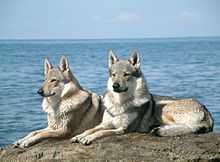Czechoslovakian wolfdog
 | |||||||||||||
| Typical female | |||||||||||||
| Other names | Československý vlčiak (Slovakia) Československý vlčák (Czech Republic) Czechoslovakian Wolfdog (United Kingdom) Czechoslovakian Vlčák (United States) | ||||||||||||
|---|---|---|---|---|---|---|---|---|---|---|---|---|---|
| Country of origin | Czechoslovakia | ||||||||||||
| |||||||||||||
| |||||||||||||
| Dog (Canis lupus familiaris) | |||||||||||||
The Ceskoslovenský Vlciak, Czechoslovakian Wolfdog,[1](sk. Československý vlčiak, cz. Československý vlčák) is a relatively new breed of dog that traces its original lineage to an experiment conducted in 1955 in Czechoslovakia. After initially breeding 48 working line German Shepherds with four Carpathian wolves, a plan was worked out to create a breed that would have the temperament, pack mentality, and trainability of the German Shepherd and the strength, physical build, and stamina of the Carpathian wolf. The breed was engineered as attack dogs for use in military Special Operations done by the Czechoslovak Special Forces commandos but were later also used in search and rescue, schutzhund, tracking, herding, agility, obedience, hunting, and drafting. It was officially recognized as a national breed in Czechoslovakia in 1982; in 1989 it became FCI standard no. 332, group 1, section 1.
Appearance

Both the build and the hair of the Czechoslovakian Wolfdog are reminiscent of a wolf. The lowest dewlap height is 65 cm (26 in) for a male and 60 cm for a female and there is no upper limit. The body frame is rectangular, ratio of the height to length is 9:10 or less. They typically weigh around 54 pounds (26 kg) for males and 44 pounds (20 kg) for females. The expression of the head must indicate the sex. Amber eyes set obliquely and short upright ears of a triangle shape are its characteristic features. The set of teeth is complete (42); very strong; both scissors-shaped and plier-shaped setting of the dentition is acceptable. The spine is straight, strong in movement, with a short loin. The chest is large, flat rather than barrel-shaped. The belly is strong and drawn in. The back is short, slightly sloped, the tail is high set; when freely lowered it reaches the tarsuses. The fore limbs are straight, and narrow set, with the paws slightly turned out, with a long radius and metacarpus. The hind limbs are muscular with a long calf and instep.

The color of the hair is from yellow-grey to silver-grey, with a light mask. The hair is straight, close and very thick. The Czechoslovakian Wolfdog is a typical tenacious canterer; its movement is light and harmonious, its steps are long.
Temperament
The Czechoslovakian Wolfdog is more versatile than specialized. It is quick, lively, very active, and courageous. Distinct from the character of Saarloos Wolfhound, shyness is a disqualifying fault in the Czechoslovakian Wolfdog.
The Czechoslovakian Wolfdog develops a very strong social relationship - not only with their owner, but with the whole family. It can easily learn to live with other domestic animals which belong to the family; however, difficulties can occur in encounters with strange animals. It is vital to subdue the Czechoslovakian Wolfdog's passion for hunting when they are puppies to avoid aggressive behavior towards smaller animals as an adult. The puppy should never be isolated in the kennel; it must be socialized and get used to different surroundings. Female Czechoslovakian Wolfdogs tend to be more easily controllable, but both genders often experience a stormy adolescence.

The Czechoslovakian Wolfdog is very playful and temperamental. It learns easily. However, it does not train spontaneously, the behavior of the Czech Wolfdog is strictly purposeful - it is necessary to find motivation for training. The most frequent cause of failure is usually the fact that the dog is tired out with long useless repetitions of the same exercise, which results in the loss of motivation. These dogs have admirable senses and are very good at following trails. They are very independent and can cooperate in the pack with a special purposefulness. If required, they can easily shift their activity to the night hours. Sometimes problems can occur during their training when barking is required. Czechoslovakian Wolfdogs have a much wider range of means of expressing themselves and barking is unnatural for them; they try to communicate with their masters in other ways (mainly body language but also use quiet noises as in growls, grunts, and whining). Generally, teaching the Czechoslovakian Wolfdog stable and reliable performance takes a bit longer than teaching traditional specialized breeds. The Czechoslovakian Wolfdog has been successfully employed as a Search And Rescue (SAR) dog in Italy, although, admittedly, handling one is much more work.
External links
- Official Worldwide information site and database of all pure Czechoslovakian Wolfdogs
- Site dedicated to statistics on the breed
- Klub chovateľov československého vlčiaka Slovenskej republiky (KCHČSV SR)
- Czechoslovakian Vlcak Club of America
- Czechoslovakian Vlciak Club of Great Britain
- Czechoslovakian Vlcak Information and Breed Club of Great Britain
- ↑ FCI-Standard N° 332 / 03. 09. 1999 / GB
| |||||||
| |||||||
| |||||||||||||||||||||||||||||||||||